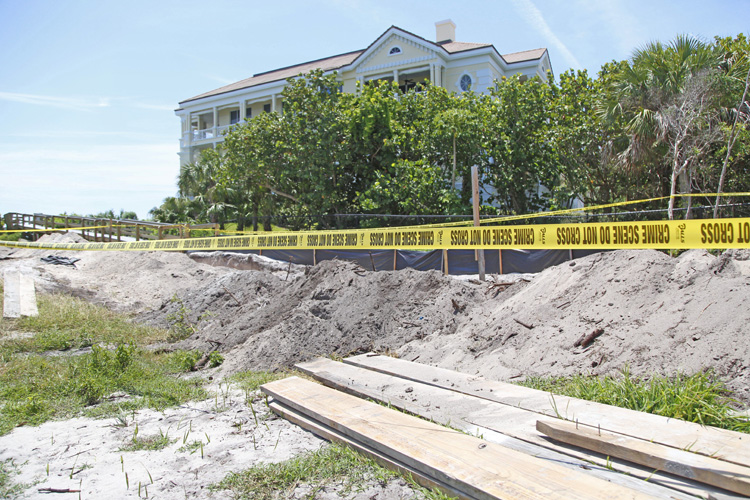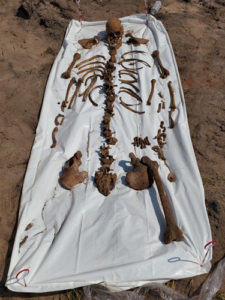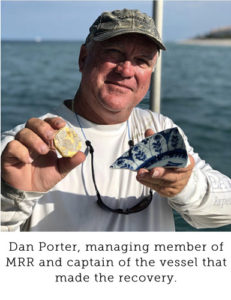
The Treasure Coast holds many mysteries, and whether you go looking for them or not, the land and the sea sometimes give up their secrets.
Two crews were toiling away last week about 100 yards apart – one searching for sunken treasure and the other preparing to build $20 million worth of luxury, oceanfront condominiums. Both crews found something out of the ordinary.

[Photo: Provided]
The community got site plan approval from the Indian River Shores Planning Zoning and Variance Board in May and there’s an open-air sales office already in place on the 4.7-acre parcel. At least five of the 21 planned units have already been sold, according to a ground-breaking pricing sheet, and Zana is eager to get the condos built.
It was just after lunchtime when the backhoe operator fired up his machine. “They were digging footers for a site wall,” Zana said.
“That backhoe driver came across that skull and it startled him. He immediately called 911,” said Capt. Mark Shaw of the Indian River Shores Public Safety Department, who was on duty at about 12:30 when the call came in.
The construction worker did exactly what was required by Florida Statute whenever human bones are unearthed. Work stopped and the area was cordoned off and treated as a crime scene while authorities investigated.
The Shores responded to the 911 call and alerted the Medical Examiner. Shaw called for backup in the form of a crime scene unit from the Indian River County Sheriff’s Office. “They have special hand tools to do this properly, you can’t just go digging up remains,” Shaw said. Two forensic specialists gently excavated the site.
Zana said the bones were not buried too deep, only 2 feet down. Shaw said the remains were found about 50 yards or so from the shoreline.
Shores officers laid out a tarp to carefully collect anything that was found. They re-purposed the wooden stakes the construction crew had previously pounded into the ground for their own job site to stretch yellow crime scene tape around the immediate area.
The first thing police had to determine was whether the remains are of “forensic age” – meaning 75 years old or less and possibly related to an unsolved crime or missing person case – or of “archaeological age.”
Shores Public Safety Chief Rich Rosell said the crime scene crew’s initial assessment was vague, but that the near-intact skeleton was “very old” and not of forensic age.
The team spent five hours uncovering red-hued bones, large and small, until the crime scene techs were satisfied they’d gotten all there was to be found – a nearly intact, adult human skeleton.
“We did not find one shoe or one button, nothing. Just some really worn fibers than maybe could have been leather, but they were tiny and really degraded,” Shaw said, noting the fibers could have been some sort of storm-blown debris and not related to the remains. The lack of artifacts next to the skeleton only adds to the mystery.
 Meanwhile, nearby, another crew was working on the ocean floor just as carefully as the officers on land, hoping for a lucky find, on the heels of a small victory the previous day. “The whole time we were out there working, there was a treasure salvage boat maybe 100 yards away,” Shaw said.
Meanwhile, nearby, another crew was working on the ocean floor just as carefully as the officers on land, hoping for a lucky find, on the heels of a small victory the previous day. “The whole time we were out there working, there was a treasure salvage boat maybe 100 yards away,” Shaw said.
It’s been four years since the last major jackpot from the 1715 Spanish Plate Fleet, a $4.5 million find. Treasure hunters from Marine Research and Recovery LLC operating in three boats have found lots of musket balls, some random jewelry, a few coins and a silver fork this year, but nothing really special – until last Tuesday.
The day before the Blue at 8050 Ocean crew bumped up against a human skull, diver Kenton Dickinson found a solid gold religious artifact, which MRR described as possibly “a reliquary or a vessel to carry the (communion) Host.”
Treasure hunter Dan Porter’s Capitana boat also found a large piece of blue and white K’ang Hsi china which dates to the late 17th century. Both finds are thought to be from a flotilla of Spanish merchant ships, 11 of which wrecked in a hurricane off Vero’s coast in 1715 as they sailed back home from Cuba to Spain, loaded with gold and other cargo from the New World.
Buoyed by the glint of 300-year-old gold, and the excitement of breaking their long dry spell with the first major find of the 2019 season, the treasure-hunting crews were out on the water at Corrigan’s Wreck again, just offshore, as the forensics team unearthed what is speculated to be a survivor of those Spanish shipwrecks.
Back on land, the police officers photographed the site, organized the bones on the white tarp, bagged up the remains and took them into custody at the Indian River Shores Public Safety station.
The following morning, they drove them down to the Fort Pierce office of the Medical Examiner for the 19th Judicial Circuit.
The next stop for the batch of old bones, Shaw and Rosell said, is a university archaeology lab, most likely the University of Florida in Gainesville. If so, that would be UF’s Laboratory of Southeastern Archaeology, which investigates all the way back to hunter-gatherer Florida residents 11,000 years ago and specializes in the St. John’s River Valley in Northern Florida.
Scientists use a variety of means to determine the age of remains like those found in the Shores, said Registered Public Archaeology Coordinator Rachael Kangas of Florida Atlantic University, including carbon dating, DNA sampling and dental examinations.
“They will look to see if there is any dental work and at the patterns of tooth grinding. If there is a filling they will determine what material was used,” Kangas said. The filling material, or techniques of dentistry employed, could help pinpoint the historical era in which the deceased lived.
Carbon dating is a complex, 11-step process that, according to the Smithsonian Institution, compares the levels of two different types of carbon in the bones. One type of carbon is stable, while the other decays from the moment of death. Archaeologists know the levels of carbon in the typical human bone when it’s still alive. So by comparing the levels of the two types of carbon, they can estimate how long ago the person died.
DNA can sometimes be used, Kangas said, “but the viability of the DNA would depend upon how preserved the remains are. You’d need them to be preserved enough to collect the DNA.”
What’s next for Blue at 8050 Ocean and Zana’s tight construction schedule?
Chapter 872 of Florida Statutes says “Within 15 days after the discovery of human remains, the archaeologist conducting the excavation shall report to the State Archaeologist his or her opinion regarding the biological and cultural characteristics of the remains.”
But Zana is hoping for an answer sooner than that.
“I was told it would only take five days to hear something back. If the information I was given is correct, then my site will be released shortly,” he said.
Zana’s luxury condominium community is being built just north of The Carlton condominium, another development that had a visitor from the past. Long-time Shores Public Safety officers remember human remains being found at the Carlton site when developer Mason Simpson was clearing the land in 1998.
The Carlton and Blue at 8050 Ocean are about seven miles south of the 1715 Fleet Survivors’ and Salvagers’ Camp, which is on the National Register of Historic Places, its landmark being the McLarty Treasure Museum north of Windsor.
Left without ships to take them back to Spain, the estimated 1,500 survivors of the hurricane had to camp out as they struggled to survive, and some decided to settle and explore wild Florida. Later, pirates and treasure hunters also used the camp.



